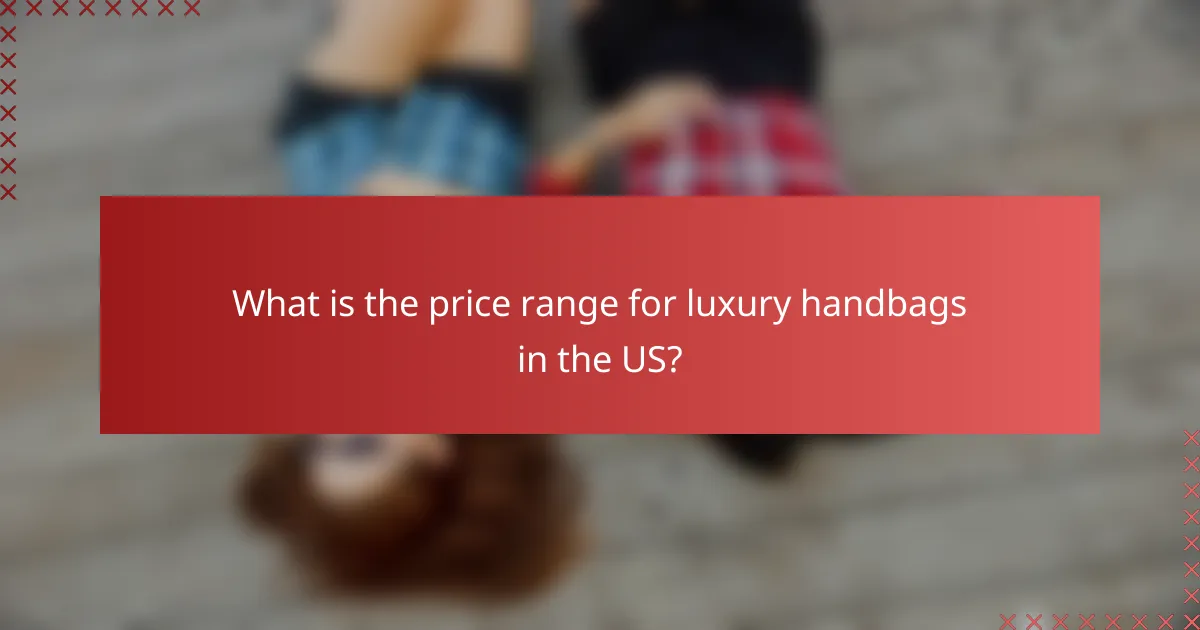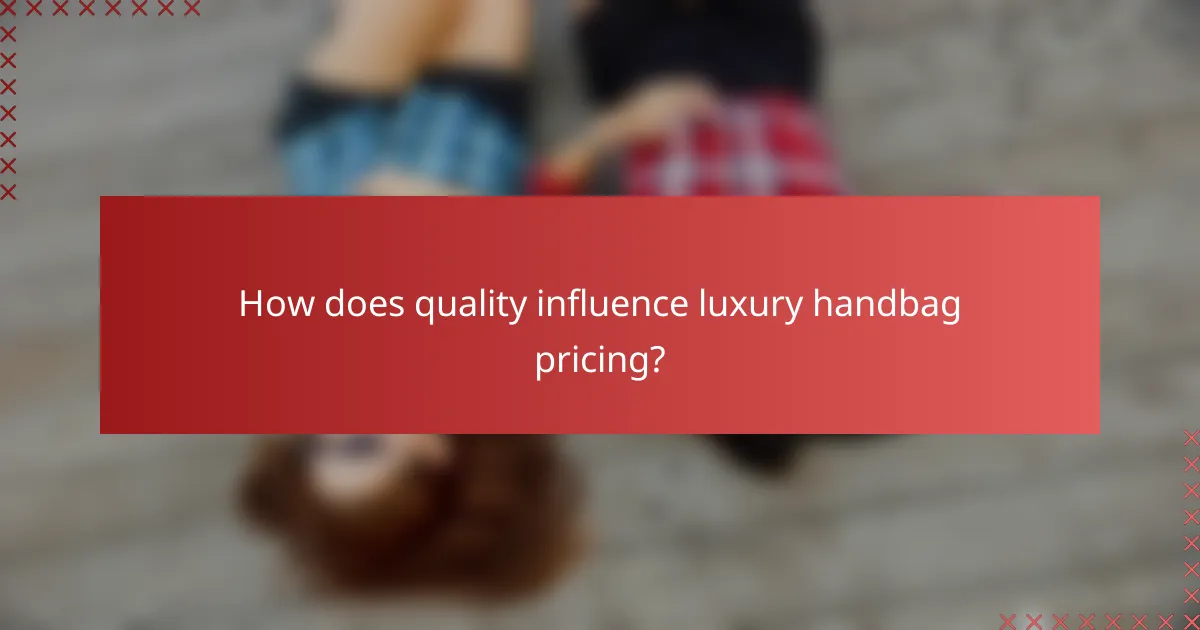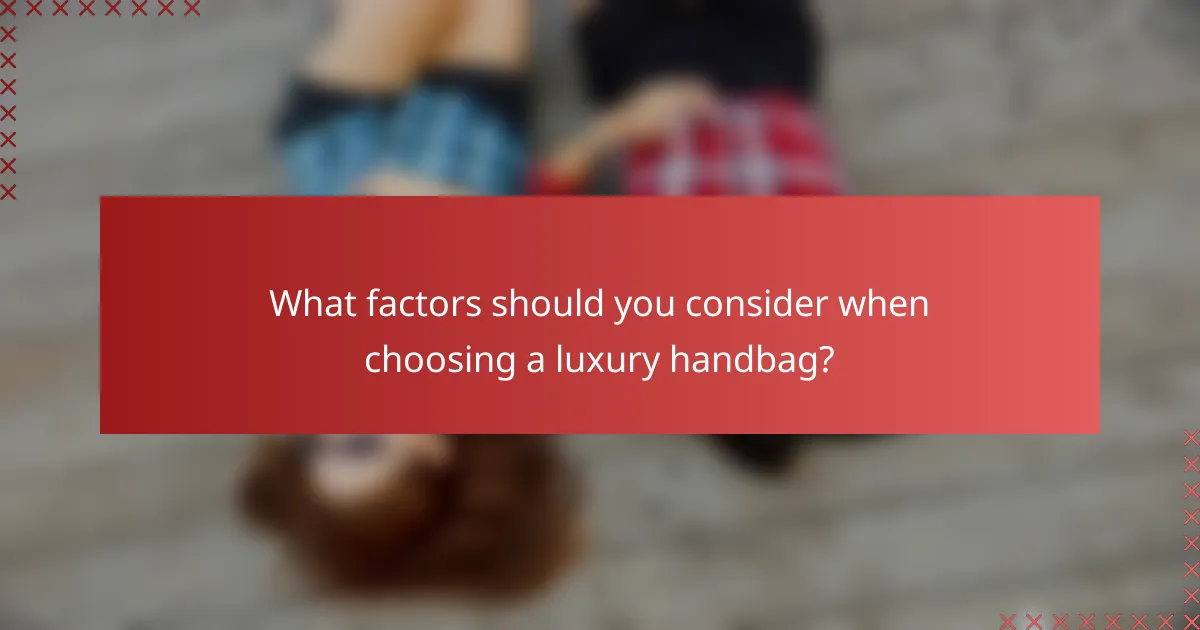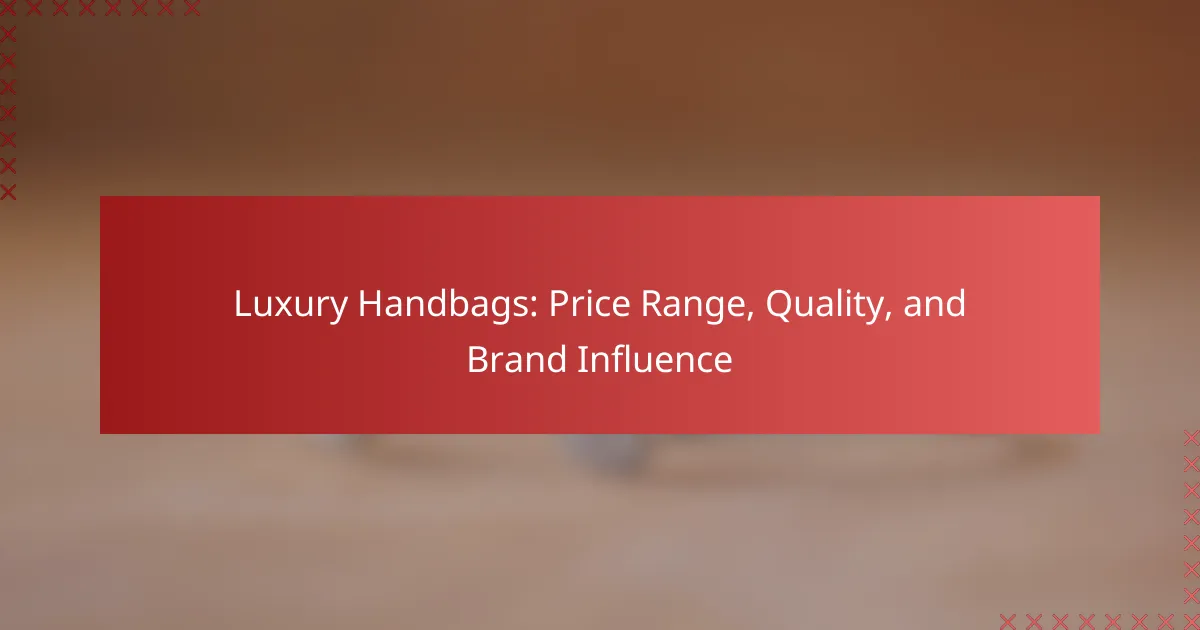Luxury handbags represent a significant investment, with prices ranging from approximately $500 for entry-level options to over $5,000 for high-end designer pieces. The quality of materials and craftsmanship plays a crucial role in determining these prices, as consumers often seek durability and aesthetic appeal alongside brand prestige. Renowned brands like Louis Vuitton, Chanel, and Gucci continue to dominate the market, offering unique styles that reflect their heritage and status.

What is the price range for luxury handbags in the US?
The price range for luxury handbags in the US varies significantly based on brand reputation and quality. Generally, you can expect to pay anywhere from around $500 for entry-level luxury bags to over $5,000 for high-end designer pieces.
$500 to $1,500 for entry-level brands
Examples of entry-level brands include Michael Kors, Tory Burch, and Coach. These bags often feature recognizable logos and are popular among consumers seeking a taste of luxury.
$1,500 to $5,000 for mid-tier luxury brands
Mid-tier luxury handbags fall within the $1,500 to $5,000 range. These brands provide higher quality craftsmanship and materials, often with more exclusive designs. Investing in a mid-tier bag can be a step up in both style and durability.
Brands like Marc Jacobs, Prada, and Burberry are commonly found in this price bracket. Their bags often feature unique designs and limited editions, appealing to fashion enthusiasts looking for something special.
Over $5,000 for high-end designer brands
High-end designer handbags start at $5,000 and can reach well into the tens of thousands. These pieces are crafted from the finest materials and are often handmade, reflecting exceptional artistry and exclusivity.
Notable brands in this category include Chanel, Louis Vuitton, and Hermès. Owning a handbag from these labels is often seen as a status symbol, and their value can appreciate over time, making them sought-after investments.

How does quality influence luxury handbag pricing?
Quality significantly impacts the pricing of luxury handbags, as higher-quality materials and superior craftsmanship typically lead to higher costs. Consumers often pay a premium for bags that offer durability, aesthetic appeal, and brand prestige.
Materials used in production
The materials chosen for luxury handbags are crucial in determining their quality and price. Common high-end materials include genuine leather, exotic skins like crocodile or python, and premium fabrics such as silk or canvas. The sourcing and treatment of these materials can also affect the final price, with ethically sourced and sustainably produced options often commanding higher costs.
For example, a handbag made from full-grain leather will generally be more expensive than one made from corrected-grain leather due to the former’s durability and natural appearance. Additionally, the use of unique or rare materials can elevate the price significantly.
Craftsmanship and manufacturing processes
The craftsmanship involved in creating luxury handbags plays a vital role in their quality and pricing. Handcrafted bags, which often involve meticulous attention to detail, can take several hours to produce, contributing to their higher price tag. Brands that employ skilled artisans and traditional techniques typically offer products that are more durable and aesthetically pleasing.
Manufacturing processes such as hand-stitching, precise cutting, and quality control checks ensure that each bag meets high standards. Brands that emphasize artisanal craftsmanship often highlight these processes in their marketing, appealing to consumers who value quality over mass production.
Brand reputation and heritage
The reputation and heritage of a brand significantly influence the perceived value of its handbags. Established luxury brands with a long history, such as Chanel or Louis Vuitton, often command higher prices due to their legacy and status in the fashion industry. Consumers are willing to pay more for the assurance of quality and exclusivity that comes with these renowned labels.
Additionally, brand storytelling and heritage can enhance the emotional connection consumers have with a handbag, further justifying its price. Newer brands may struggle to compete on price without a strong narrative or unique selling proposition that resonates with consumers.

Which brands are considered top luxury handbag makers?
Top luxury handbag makers are renowned for their craftsmanship, heritage, and status. Brands like Louis Vuitton, Chanel, and Gucci consistently rank among the most prestigious in the luxury market, each offering unique styles and iconic designs.
Louis Vuitton
Louis Vuitton is celebrated for its timeless designs and high-quality materials. The brand’s monogram canvas and leather handbags are not only fashionable but also highly durable, making them a worthwhile investment.
Prices for Louis Vuitton handbags typically range from around $1,000 to over $5,000, depending on the style and collection. The brand’s limited editions and collaborations can command even higher prices, reflecting their exclusivity.
Chanel
Chanel is synonymous with elegance and sophistication, particularly known for its classic quilted bags and the iconic Chanel 2.55. The brand emphasizes craftsmanship, often using premium lambskin and caviar leather.
Chanel handbags usually start at approximately $3,000 and can exceed $10,000 for more elaborate designs. The brand’s bags often retain or appreciate in value, making them a popular choice among collectors.
Gucci
Gucci stands out for its bold designs and innovative styles, often incorporating vibrant colors and unique patterns. The brand’s handbags frequently feature the signature GG logo and are crafted from high-quality materials.
Prices for Gucci handbags generally range from about $1,200 to $4,000. Limited edition pieces or those from special collaborations can be priced higher, appealing to fashion-forward consumers looking for standout accessories.

What factors should you consider when choosing a luxury handbag?
When selecting a luxury handbag, consider style, functionality, and brand reputation. These factors significantly influence your satisfaction and the bag’s long-term value.
Style and design preferences
Your personal style plays a crucial role in choosing a luxury handbag. Consider whether you prefer classic designs, trendy aesthetics, or unique artistic expressions. Popular styles include totes, crossbody bags, and clutches, each serving different occasions and outfits.
Additionally, color and material are essential. Leather, canvas, and exotic skins offer various looks and durability levels. Aim for a design that complements your wardrobe and reflects your personality.
Functionality and size
Functionality is vital when selecting a luxury handbag. Assess how you plan to use the bag—whether for daily errands, work, or special events. A practical handbag should accommodate your essentials like a wallet, phone, and makeup without feeling cramped.
Size matters too. Consider dimensions that suit your lifestyle; a medium-sized bag is often versatile, while larger bags are ideal for carrying more items. Ensure the handbag’s weight is manageable, especially if you plan to use it frequently.
Resale value and brand prestige
Resale value is an important consideration in the luxury handbag market. Certain brands, like Chanel or Hermès, tend to retain or even increase in value over time. Research the brand’s reputation and historical resale trends to make an informed decision.
Brand prestige can also influence your choice. High-end brands often signify quality and craftsmanship, but they may come with a higher price tag. Weigh the benefits of investing in a well-known brand against your budget and personal preferences.

How do luxury handbag brands influence consumer perceptions?
Luxury handbag brands significantly shape consumer perceptions through their established reputations, marketing techniques, and overall brand narratives. These brands create an image of exclusivity and quality that influences buying decisions and consumer loyalty.
Brand storytelling and marketing strategies
Brand storytelling is a powerful tool that luxury handbag brands use to create emotional connections with consumers. By sharing their heritage, craftsmanship, and unique design philosophies, these brands can evoke feelings of aspiration and desire. Effective marketing strategies often include high-quality visuals, engaging narratives, and targeted campaigns that resonate with their audience.
For example, brands like Louis Vuitton and Chanel often highlight their rich histories and iconic designs in their advertising. This storytelling not only enhances brand prestige but also reinforces consumer perceptions of quality and exclusivity, making the products more desirable.
Celebrity endorsements and collaborations
Celebrity endorsements play a crucial role in shaping consumer perceptions of luxury handbag brands. When a well-known figure is seen carrying a specific handbag, it can elevate the brand’s status and desirability. Collaborations with celebrities or fashion icons often result in limited-edition collections that create buzz and urgency among consumers.
For instance, collaborations like the one between Gucci and Harry Styles have generated significant attention and sales, demonstrating how celebrity influence can drive consumer interest. However, brands must carefully select ambassadors who align with their values to maintain authenticity and appeal.
